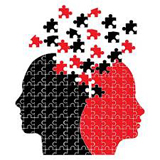Notes on counselling
Analytical and synthetic approaches in psychology and psychiatry
Abstract
A whole-person narrative needs both an analytical and synthetic approach for psycho-pathology. Creativity and spirituality can co-exist in a single individual. An analytical perspective that encompasses physical, psychological and social dimensions needs to be studied in the context of a spiritual dimension of consciousness.
One major problem with consciousness is that it is a complex subject with not only multiple dimensions but multiple viewpoints. Scientists approach consciousness from different perspectives and each viewpoint has its own validity. However, mystics experience consciousness in a different way. It is realised as a vast ethereal matrix that is universal in extension, unitary in essence and transcends the individual. Sri Aurobindo explains how this unitary consciousness in its highest creative poise (which he calls the Supermind) actually becomes all the worlds and planes of existence, but without losing its unity. This integral perspective, in which the One and the Many exist simultaneously, justifies the study of consciousness along multiple dimensions as well as simultaneously from a unitary viewpoint. In practical terms, this means that human behaviour should not only be considered analytically but also from a synthetic standpoint.
The incompleteness of the analytical approach becomes apparent when we try to understand creative geniuses. For instance, the mental status of Vincent Van Gogh has been studied from various angles. He has been considered to suffer from one disease or another, ranging from schizophrenia, bipolar disorder, and epilepsy to acute intermittent porphyria and even Meniere’s disease. Some enthusiastic researchers have also discovered alterations of his mental state in some of his paintings. A symposium of thirty international medical experts at September 14th and 15th, 2016 weighed all available evidence and analysed competing theories to conclude that nothing definitive could be pronounced about his medical status, except that the diagnosis in his last years was probably more prosaic (1). What is interesting is that no analytical approach could explain the magnificent creativity of Van Gogh. That might not be possible unless a synthetic perspective is used. This endeavour gets more significant when we try to study a personality where spiritual and psycho-pathological elements are concurrently manifest as the following case study shows. Here the subject not only suffers from delusions but is also a creative artist and simultaneously a sincere spiritual aspirant.
Vignette
A youngster was exceptionally talented in multiple modalities. He painted exquisitely, played cricket with sophistication, was an amazing flautist, developed marked percussion skills, wrote poetry with an intellectual flair, and practis=ed hathayoga exercises together with meditative sessions. Sometime in his late thirties, around 1970, he developed schizophrenic symptoms at a time when his family lost its affluent stature due to a mismanagement of funds. He had a delusional idea that Indian politicians deposited black money in Swiss banks, which legitimately should have been distributed among the citizens of the country. This idea became so compelling that in the late 1970s, he stopped going to his office for he felt the wrongdoing should be corrected. (It is interesting that the Indian Parliamentary election in 2014 was mainly fought around the issue of illegal money being stashed in Swiss banks that needed retrieval for distribution in the country).
Subsequently, after a gap of nearly a decade, he started going to the office again when he was put on a very light dose of anti-psychotic medication. His dosage was kept at a minimum so as not to interfere with his creativity, for he pursued his paintings with great enthusiasm up to his mid-70s. There were, of course, certain pictures that he modified in accordance with his mental state. For example, he drew a splendid portrait of Lenin but after some years, took out that painting and put two doves on Lenin’s shoulders! His poetry camouflaged his delusional self-references in such a way that only those who knew him understood the hidden meaning. He was an avid viewer of Hollywood movies of the 1960s and 1970s, and much to the delight of the votaries of Bleuler’s loosening of associations (a characteristic of schizophrenia where illogical associations are made), he would discover impossible similarities. For example, he declared a renowned Indian film director as a cheat as the movement of a ripple in a lake just prior to the blooming of a lotus was copied from a similar ripple in the sand of Sahara desert just before a skeletal hand jutted out in a Hollywood film!
All along, he practiced his spirituality. He harboured some queer persecutory ideas about an occultist with whom he was once acquainted. Yet his core spiritual insight was intact and he meticulously performed his āsanas (yogic postures in hathayoga) till his eighties. It is very difficult for anyone with even a good physique to practice intricate āsanas (including the posture of meditating while standing on one’s head) but his deep spiritual conviction carried him through. In his mid-fifties, he suddenly decided to marry in order to have someone to look after him in old age! He had a marriage, which clicked as his wife regarded his spiritual perspective with awe and respect while choosing to downplay his delusional ideas. His interpersonal relations also remained amicable. Due to his sterling qualities, people chose to ignore his mental aberrations. To an average person who knew him, his spiritual perspective was always more important than his crazy ideas.
When he was about 85, he began to display mild memory disturbances. When this scribe asked him to recollect a past memorable event which obviously he could not, he rationalised and answered that these golden moments were gone forever and what was more important was to remain calm and undisturbed!
In retrospect, this patient’s schizophrenic delusion about black money in Swiss banks had an intuitive element. Was it due to the mystical side of his character? Can delusion per se get modified in mystic states? The relationship between psychosis and mysticism is very complex and it is known that spiritual aspirants can become psychotic if they are over-zealous in their spiritual pursuit without stabilising themselves. In the present case, a standard psychiatric evaluation of the subject would assess his delusional state, but would not have shown how his spiritual perspective had a synthetic value in his life.
The integral perspective therefore requires an approach to consciousness that accepts both analytical and synthetic viewpoints. At the analytical level, there are certain basic dimensions to be considered while studying the human psyche, none of which is superior or inferior to the other, but exist together in the matrix of consciousness. These basic dimensions include the physical, the psychological and the social dimensions. At the synthetic level, an attempt should be made to study the spiritual dimensions of personality, while acknowledging that it is difficult for psychology to assess this completely and accurately. Evidently, the conventional approach to clinical psychology and psychiatry tends to omit the synthetic element, so a new consciousness-based psychology is needed to provide a more comprehensive and compassionate approach for a whole-person narrative.
We shall now try to understand the different dimensions of consciousness to see how we can simultaneously operate with analytical and synthetic perspectives.
The Physical dimension
The human being is to begin with a physical being in the sense that the superstructure of living systems has been built upon a physical template. Hence, the physical dimension of a consciousness model should initially address the phenomenon of ‘awareness’ in neurological, physiological, psycho-physiological, genetic, developmental, cognitive, information processing, computational and other allied terms. This level should explore the physical basis of the ‘contents’ of consciousness (viz. sensations, emotions, images, memories, ideas) as well as the ‘states’ of consciousness (modulated through the ascending reticular activating system).
However the scientific approach that attempts to understand physical reality by building-blocks from below upwards is no longer entirely viable. This has now been acknowledged by physics, which has shown that sub-atomic particles like leptons and quarks can no longer be divided further as they lapse into formlessness. For consciousness studies, this means we should try to understand how consciousness qua consciousness gets organised, without assuming that it is caused by some ultimate material substrate. It is not enough to probe the physical consciousness at the physical plane alone, it also needs to be probed from a higher non-physical perspective, as mystics and seers have done.
The psychological dimension
The psychological dimension of a consciousness perspective should be a search to understand ‘oneself’ in psychological terms, as distinct from the attempt to understand ‘awareness’ in physical terms. In psychological parlance, ‘oneself’ may refer to a variety of constructs: for some it is the ego perceived as an organiser of the ‘psyche’, for others it may be a ‘self’ that is conceived as an independent centre for initiative and action and experienced as continuous in time and space, or it may be a central principle which is again connected to a deeper spiritual Reality, or independent of it or a projection of it. Many psychological theories find it difficult to define the ‘self’, and the effort becomes more complicated if the personal self is conceived to be a projection either of a wider cosmic Self or an even higher transcendental Self. For if the self exceeds the limitations of the person, it becomes not only universal but somewhat omnipresent, which makes it difficult to be discerned in perceptual terms. In that case, this larger scope of self needs to be probed not through scientific experiments but by deeper introspective methods that traverse the inner ranges of consciousness.
Also, the ’self’ is influenced by diverse forces that one may or may not be aware of in the waking state. Those forces that we are not ordinarily aware of have been termed as ‘unconscious’ in psychology, and studied both in the individual and in the collective sense. Some of the forces that one is unaware of in the waking state have also been studied throughout the ages by occultists and shamans, and in contemporary science by parapsychologists. A consciousness-based approach to psychology needs to include all of these domains and dimensions, and not exclude forces of which we are ordinarily only partially aware, or to a large extent unaware. It should also not exclude forces of which some people are aware and others not.
In fact, among the most important contributions of Aurobindonian thought to psychology is the detailed and methodical exploration of the inner ranges of the being that stand behind the surface personality and are normally inaccessible. It can be judiciously said that a psychological perspective based on the consciousness perspective of Sri Aurobindo’s vision is relevant only when the surface personality is exceeded in the inner ranges of the being, where the ego is replaced by a fourth-dimensional principle. The discordant parts of the being can be then integrated around this deeper ego-surpassing soul-principle (the psychic being) to make the human receptacle fit for a transformative journey.
The social dimension
The human being is not only an individual being but is also a social being. Indeed, the Latin term ‘conscious’, from which the term consciousness was derived, had in its inception a social connotation as it meant mutually shared knowledge. Our socio-cultural transactions reveal another aspect of consciousness that is manifested in social norms, cultural traditions, economic motives, anthropological perspectives and in ethical, political and aesthetic values. The relationship between the individual and the collectivity remains complex, more so as they interpenetrate each other. Moreover, the collectivity is not merely a physical aggregate; it has non-physical aspects as well, which are necessary to understand. Phenomena like violence, ethnocentrism, fanaticism, drug abuse, globalisation, class conflicts, crowd behaviour, gender issues and changing familial values. The social dimension of a consciousness model should address this collective consciousness vis-a-vis the individual consciousness.
Indian spirituality has been conventionally criticised for having laid more emphasis on individual salvation rather than on the flowering of the collective consciousness. Sri Aurobindo dealt with this imbalance at two important levels. First, at the psychological level, he envisioned how the inner freedom, liberty and equality could be harmonised with the outer freedom, liberty and equality to construct a consciousness paradigm of global human unity. Secondly, He charted a progressive evolution of consciousness along a transformative trajectory to describe how transformed individuals would constitute higher-order gnostic collectivities.
The spiritual dimension
The world belongs as much to the scientist and the pragmatist as to the mystic, the saint and the seer. Psychology has not only to concern itself with the consciousness of the average person, but also with the consciousness of Christ and the Buddha. Ordinarily, the term ‘oneself’ refers to the experience of an individual who is anatomically limited by the skin, physiologically modulated by the senses, psychologically organised around the ego and cognitively guided by reason. However, mystical and spiritual experience have testified that one can cultivate a poise of universality in which the limitations of the body, the senses, the ego and the mind disappear, and one becomes aware of a ‘cosmic consciousness’ where universal forces play, intermingle and interact with the individual consciousness. In the cosmic consciousness, one feels identified with the universe (in the metaphysical sense), in other words, the individual self is identified with the cosmic self. The sense of the individual ‘I’ changes to a poise of universality. When spiritual seekers in India tried to understand the raison-d-être of this experience of ‘universality’ vis-a-vis ‘individuality’, they discovered a poise of ‘transcendence’, which supported and surpassed both the individuality and the universality. They found that it was the same consciousness that expressed itself simultaneously in the three different poises of transcendence, universality and individuality and named it as the True Being or Brahman. Yogis have described that on gaining the highest mystic realisation, one makes an immediate experiential contact with this Being or Brahman as ‘pure consciousness’. This Being (Brahman) experienced as the ground of the universe was also identified with the Self (Atman), the ground of our psychological existence. Thus, a consciousness-based model of psychology has to take cognisance of this spiritual reality that is no less valid then the material reality.
Vignette
A medical anthropologist from the UK, who had some exposure to shamanism, was interviewing spiritual and occult healers in India to find out how they viewed psychiatric problems and whether they collaborated with modern psychiatrists. She went to a remote village near the India-Bangladesh border and interviewed a venerated Muslim spiritual faith healer. He was in his late seventies but still catered daily to a large clientele from all faiths. He explained to the anthropologist how he differentiated cases needing occult intervention and herbal remedies from those who had to be treated not by him but by a modern psychiatric practitioner, who would prescribe psychotropic medication. He also clarified that even in cases treated by him, some needed concurrent pharmacological treatment, too, for which he also made referrals. When asked if as a mystic, he had any reservations about taking help from modern psychiatry, he gave a beautiful answer — “Let sādhanā (spiritual pursuit) and gavesana (scientific research) go together — where is the conflict?”
Clearly this remarkable mystic has an integrated approach to treatment. For the field of psychology, the question remains unanswered: how can the two perspectives, the spiritual and the scientific, be optimally combined? An initial exploration of these issues is documented by the anthropologist mentioned above, Natalie Tobert, who has written a fascinating book on her study of traditional healers, patients and modern psychiatrists in India, Spiritual Psychiatries (2).
The relation between the spiritual and scientific paradigms
The spiritual and mechanistic paradigms of consciousness are so far removed from each other that it would be relevant to ponder whether it is worthwhile to forcibly reduce one in terms of the other. Instead, perhaps it would be more meaningful to keep the two paradigms separate for conceptual, theoretical, practical and heuristic reasons. If a link could be established between the two paradigms, then our whole perspective of consciousness research would change.
A link can actually be made between the two paradigms if we consider the yogic insight that the macrocosm is represented in the microcosm and the microcosm is represented in the macrocosm. In other words, this is meant to imply that a higher level of Reality can be represented at a lower level of reality.
The mystic and the spiritual seeker deal with the higher level of Reality, while the scientist and the materialist deal with the earthly reality implying a duality implicit in reality itself. Sri Aurobindo explained that this duality is not infallible and is not a “law of manifestation”; rather it is “a circumstance” of evolution. Duality is just “the device of manifesting the Infinite in Ignorance through imperfect instruments (3)”.
In a reverse movement, the imperfect instruments can also be transformed into perfected archetypes not merely in the world of ideals but in the realm of manifestation. In his magnum opus, The Life Divine, he has described how the earthly reality can be transfigured in transcendental terms through an elaborate and sophisticated process of what he terms as supramental transformation. In other words, the higher Reality can manifest at the earthly level, too. Actually, it is not a question of two different realities but the same Reality that is manifested at different levels for “The Reality is one and not a sum or a concourse (4)”.
Sri Aurobindo qualified that, Reality or Brahman expresses Itself in “many successive forms of consciousness, successive in their relation even if co-existent in being or coeval in Time (5).” Further, “Brahman is integral and unifies many states of consciousness at a time (6).”
This stance helps to consider an overview of consciousness where both the synthetic spiritual paradigm and the analytical mechanistic paradigm are accommodated in their proper places in an integral poise so as to be ready for a transformational agenda. Therefore, the possibility of developing a paradigm of consciousness-based psychology that is simultaneously pluri-dimensional and integral becomes a reality.
References
1. Cascone S. Vincent van Gogh Was Definitely Crazy, but Doctors Aren’t Sure Why. The Telegraph 16th September 2016.
2. Tobert N. Spiritual Psychiatries: Mental Health Practices in India and UK. UK: Aethos; 2014.
3. Purani AB (recorded by). Evening Talks with Sri Aurobindo. 4th ed. Sri Aurobindo Ashram Trust; 2007, p. 426.
4. Sri Aurobindo. The Complete Works of Sri Aurobindo, Volume 21. Pondicherry: Sri Aurobindo Ashram Trust; 2005, p. 38.
5. Ibid., p. 41.
6. Ibid., p. 42.
Dr. Soumitra Basu, a practising psychiatrist and member of SAIIIHR, is the Director of a school of psychology, Integral Yoga Psychology. He is also one of the editors of NAMAH.
Share with us (Comments,contributions,opinions)
When reproducing this feature, please credit NAMAH,and give the byline. Please send us cuttings.








